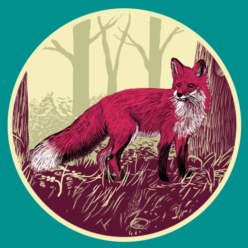////////////////////////
FR
Gwen Tomahawk est un illustrateur originaire de Fontainebleau, né en 1982. Son œuvre se distingue par une exploration approfondie de diverses techniques artistiques, notamment la carte à gratter, la gravure sous diverses formes, la peinture, le dessin sur tablette ou sur papier. Son style est marqué par une esthétique sombre et intrigante, souvent teintée d’une touche d’humour absurde et parfois assez dark. Ses visuels se distinguent par des contrastes marqués ou des couleurs vives.
Il explore des thèmes variés tels que des portraits, des saynètes, des scènes fantastiques, ésotériques, souvent ancrées dans un quotidien catastrophique, satirique, humoristique ou surréaliste.
Le style de traits de Gwen Tomahawk est marqué par une esthétique à la fois brute et maîtrisée, oscillant entre le dessin naïf et le graphisme soigné. Ses lignes sont souvent épaisses comme des cernes en pleins et déliés, assumées, et volontairement imparfaites ou plus fines et définitives avec la carte à gratter.
Ayant découvert certains expressionistes comme Erich Heckel, Otto Dix, Edvard Munch, Käthe Kollwitz, il commence à utiliser le tippex pour dessiner sur des fonds coloriés au marqueur noir. Il s’initie ensuite, début 2008, à la carte à gratter après avoir été émerveillé par une première approche avec le « Exit » de Thomas Ott. Cette technique, qui consiste à gratter une surface noire pour révéler une couche inférieure blanche, est l’une des spécialités de Gwen Tomahawk.
En 2012, il crée une première série Los Trashos, en hommage aux Crados de son enfance, qu’il gratte frénétiquement. Puis l’année suivante, il détourne le noms de célébrités dans une série à la tablette graphique : Los Incognitos.
Dans ses gravures, l’artiste a commencé par explorer des thèmes tels que la testostérone sous le visage de protagonistes de films d’action cultes en les associant à leurs punchlines sélectionnées avec soin. Par la suite, il crée des Mini-Totems sur bois, s’essaie à la gravure sur cuivre, puis par manque de moyens sur des bouts de plaques en MDF récupérés à droite à gauche. Gwen Tomahawk utilise également la technique de la pyrogravure, qui consiste à graver des motifs sur du bois à l’aide d’un outil chauffant. Cette méthode lui permet de créer des œuvres aux textures riches et aux contrastes prononcés, ajoutant une dimension tactile à son art.
Depuis 2024, il s’est remis à la linogravure, imprimant lui même ses propres travaux sous le nom d’ElectroShockPrints.
L’univers graphique de Gwen Tomahawk est également enrichi par ses contributions à des publications telles que Le Dernier Cri, Le Canard Enchaîné, CQFD Mensuel, Aaarg!, Distorsion, Speedball, Banzaï, La Décroissance, Le Garage L., Dead Zine, Charogne, Kronik Komiks, Screwtooth, Sub-stance D.Générée, L’atelier, Ortolan Zine, Béton, Anachronique,…
Il a conçu des pochettes d’albums pour des groupes comme Wakan Tanka, Buzz & Cooper Orchestra, John Linhart, Nocif ou des sorties du label Le Keupon Voyageur.
En somme, l’art de Gwen Tomahawk se caractérise par une maîtrise technique diversifiée et une esthétique singulière, mêlant des thèmes sombres à une touche d’ironie, ce qui le distingue dans le paysage artistique contemporain.
////////////////////////
EN
Gwen Tomahawk is an illustrator from Fontainebleau, born in 1982. His work stands out for its in-depth exploration of various artistic techniques, including scratchboard, engraving in multiple forms, painting, and drawing both digitally and on paper. His style is marked by a dark and intriguing aesthetic, often tinged with absurd and sometimes quite dark humor. His visuals are characterized by strong contrasts or vivid colors.
He explores a wide range of themes such as portraits, small scenes, and fantastical or esoteric imagery, often rooted in a catastrophically satirical, humorous, or surreal everyday life.
Gwen Tomahawk’s line work blends a raw yet controlled aesthetic, shifting between naive drawing and refined graphic design. His lines are often thick, like heavy outlines with intentional imperfections, or more precise and refined when using the scratchboard technique.
After discovering certain expressionist artists like Erich Heckel, Otto Dix, Edvard Munch, and Käthe Kollwitz, he began using Tipp-Ex to draw on marker-colored backgrounds. In early 2008, he discovered scratchboard art after being blown away by a first encounter with Exit by Thomas Ott. This technique—scratching a black surface to reveal a white layer underneath—has become one of Gwen Tomahawk’s specialties.
In 2012, he created his first series, Los Trashos, a frenziedly scratched homage to the Garbage Pail Kids from his childhood. The following year, he launched Los Incognitos, a series of digital illustrations that humorously twisted celebrity names.
In his engravings, the artist initially explored themes like testosterone, featuring iconic action movie characters paired with their carefully selected punchlines. He later created Mini-Totems on wood, experimented with copper engraving, and, due to limited means, turned to scavenged MDF scraps. Gwen Tomahawk also uses pyrography—a technique that involves burning designs into wood with a heated tool. This method allows him to create richly textured works with pronounced contrasts, adding a tactile dimension to his art.
Since 2024, he has returned to linocut printing, producing and printing his own work under the name ElectroShockPrints.
Gwen Tomahawk’s graphic universe is also enriched by contributions to publications such as Le Dernier Cri, Le Canard Enchaîné, CQFD Mensuel, Aaarg!, Distorsion, Speedball, Banzaï, La Décroissance, Le Garage L., Dead Zine, Charogne, Kronik Komiks, Screwtooth, Sub-stance D.Générée, L’atelier, Ortolan Zine, Béton, Anachronique, and others.
He has also designed album covers for bands like Wakan Tanka, Buzz & Cooper Orchestra, John Linhart, Nocif, and releases from the Le Keupon Voyageur label.
In short, Gwen Tomahawk’s art is defined by its technical versatility and singular aesthetic, blending dark themes with a touch of irony—making his work stand out in the contemporary art scene.
